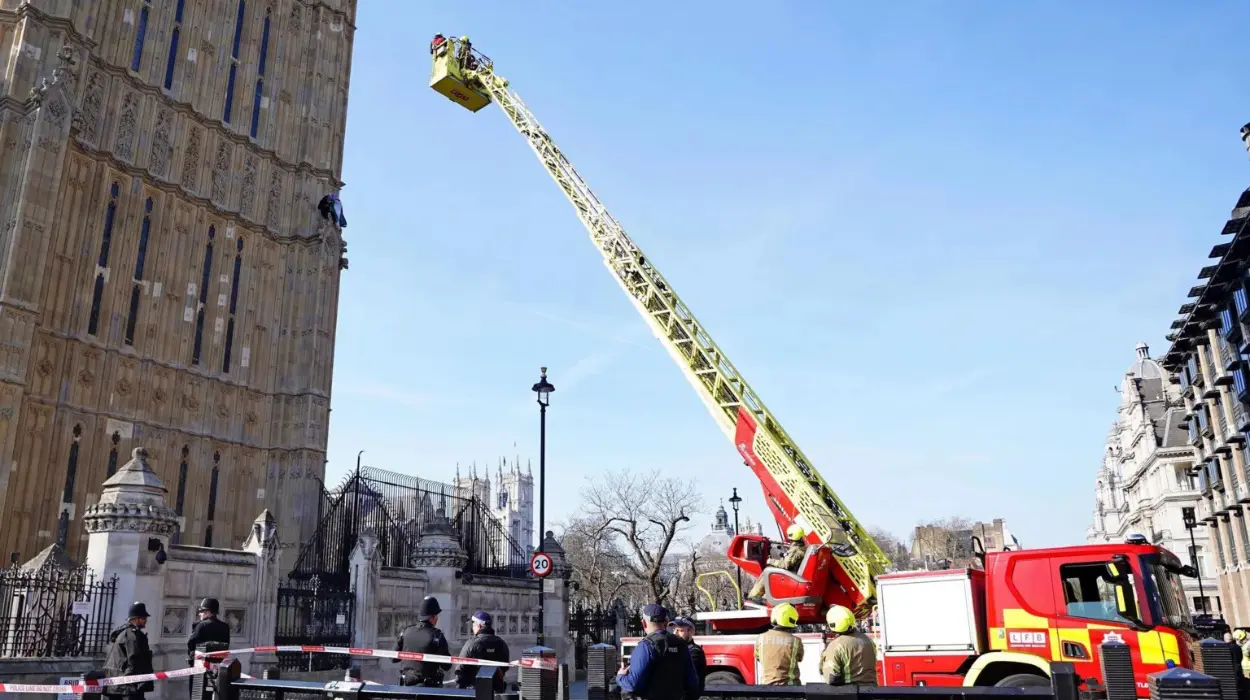City of Westminster (Parliament Politics Magazine) – Emergency services respond to protest at Palace of Westminster as man scales Elizabeth Tower, waving Palestine flag, prompting cancellation of parliamentary tours.
In what appears to be a protest, a barefoot guy was seen standing on a ledge several meters up the tower that houses Big Ben.
A parliamentary spokeswoman announced that the incident has led to the cancellation of Saturday’s parliamentary tours.
In central London, spectators watched from beyond the police cordon as at least nine emergency vehicles lined Bridge Street.
The man appears to have blood oozing from his foot in pictures.
Since negotiators were spotted conversing with the individual, no additional information regarding any injuries has been made public.
A Parliamentary spokesperson said:
“We are aware of an incident on the Parliamentary Estate this morning, which is being handled by the Metropolitan Police, assisted by the London Fire Brigade and the London Ambulance Service.
Parliament takes security extremely seriously, however we do not comment on the specifics of our security measures or mitigations.
As a result of this incident, tours of the Parliamentary Estate today have unfortunately had to be cancelled.”
Following the rise of Elizabeth Tower, home of Big Ben at the Palace of Westminster in London, a man holding a Palestine flag is seen by onlookers (James Manning/PA).
Later in the morning, while officials worked to address the situation, the entire Westminster Bridge was closed.
Due to road closures, there is a lot of traffic in the vicinity, and London bus routes 3, 11, 148, C10, and 159 are detoured.
It is known that one of the Westminster Tube station’s exits is closed, although other exits are open and Tube services are unaffected.
At 7:24 a.m. on Saturday, March 8, officers were notified that a man was climbing up the Elizabeth Tower at the Houses of Parliament, according to a Metropolitan Police spokesperson.
“Officers are at the scene working to bring the incident to a safe conclusion. They are being assisted by the London Fire Brigade and the London Ambulance Service,” Parliamentary spokesperson said.
Three emergency professionals were hoisted several meters up on a fire department aerial ladder platform at around ten in the morning on Saturday. One of them was speaking to the man on the ledge using a megaphone.
Photographs depict the man sitting on the ledge with a keffiyeh wrapped over the tower’s ornamental stonework and the flag.
When the platform was lowered at approximately 11.45 a.m., the man was still perched on the ledge.
A spokesman for London Fire Brigade (LFB) said:
“Firefighters are responding alongside the Metropolitan Police Service to reports of a person scaling the Palace of Westminster.”
Crews from Lambeth, Chelsea, Soho and Islington fire stations have been deployed, LFB added.
A tiny group of negotiators were attempting to calm the Big Ben protester down as the clock reached two o’clock.
The negotiators were speaking to him from the top of a fire engine ladder, and he was still holding on to his perch, some 15 meters above the ground, his flag fluttering in the breeze.
A tiny number of supporters pinned behind the police barricade at Victoria Embankment shouted, “Free Palestine” and “You Are A Hero.”
The taped-off area, which includes Parliament Square and the Houses of Parliament, was guarded by uniformed officers.
What security measures are in place to prevent future incidents?
Adding more CCTV cameras to strategic locations, particularly on and surrounding famous buildings like the Elizabeth Tower, can aid in monitoring and preventing unwanted entry.
Structures that are dangerous if climbed can be made inaccessible to people by erecting fence or physical barriers around sensitive regions.
Increasing the number of security guards in and around the Palace of Westminster can help prevent future occurrences and respond quickly to odd activity.
Stricter access control mechanisms, such as ID checks and limited access zones, can be put in place to restrict who is allowed to enter critical locations.
A prompt and well-coordinated response can be guaranteed by creating and upgrading emergency response protocols for circumstances in which people are trying to scale structures or carry out comparable actions.


